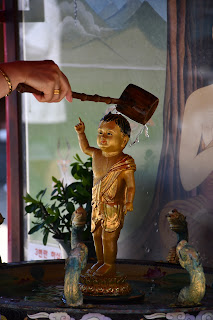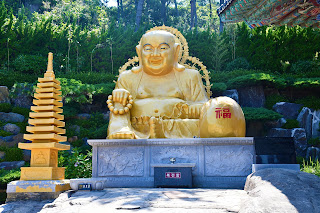Busan and Gyeongju
We arrived
in Busan in the morning to be picked up once again by our trusty guide Mr J. Our
tour began in the city, which from a distance looks like a collection of lego
blocks spilling out of the mountains. Our car climbed its way up the hill
through the narrow streets of the erewhile poor quarters, where many tiny
houses were built on the tombstones of Japanese settlers. As we learned in a
photo exhibition towards the top of the hill, the quarters were settled by
refugees. Masses of people migrated South, particularly to Busan, when US, UN
and South Korean forces were pushed out of the North by China – many had in
fact begged US ships to allow them on board, which they did unwillingly after
dumping their arms into the sea to make space. Upon their arrival in Busan, the
refugees settled on the outskirts of the city to eke out a living in awful
conditions.
The rooftops of Busan
Busan
A house built on tombstones
Narrow alleyways
A mural of refugees
A Busan rooftop
We had
lunch in a Korean barbecue place on the South, which I weathered by eating some
vegetarian ramen. My dad, though, was in seventh heaven, rejoicing finally in some
big chunks of meat. Our adventures in South Korea have been tough on both of
us, as it is a place poor in vegetarian cuisine, leaving space for nothing but
bad compromises.
Before
leaving the city proper, we made a quick stop at a local beach.
Haeundae Beach
Opposite view from Haeundae
The way to the beach
Outside the
city of Busan is the Haedong Yonggungsa, a very scenic temple nestled on the
rocky western coast. I believe that this temple too was at some point destroyed
by the Japanese, but even so it has been reconstructed with skill. Particularly
remarkable are the colourful wooden dragons on the gates and overlooking
building entrances.
A pagoda in front of Haedong Yonggungsa
A dragon at Haedong Yonggungsa's gate
Buddha's head above the entrance
A woman pouring water on baby Buddha for good luck
Budai
A stele
Little stone Buddhist statues
Stone towers above the sea
A dragon head above a building entrance
Reclining Buddha
Budai from the side
A stone pagoda above the sea
Haedong Yonggungsa
Golden Buddhist statue
Haedong Yonggungsa
From Busan,
we headed to Gyeongju, the millennium-long capital of the Silla Kingdom. Silla
was one of the Three Kingdoms battling for supremacy over the Korean peninsula
between the years 57 BCE and 668 CE. With the help of the Tang Dynasty, Silla
eventually prevailed over the rival kingdoms of Goguryeo and Baekje. Only in
918 did the new dynasty of Goryeo defeat Silla, conquer the remaining outposts
of the rival kingdoms, and establish what are more or less Korea’s present
boundaries.
Our last
two stops of the day were Tumuli Park (Tumuli-gongwon) and the Gyeongju
National Museum. Tumuli Park houses 23 impressive tombs of Silla monarchs and
other royal family members. From the outside, they are very round, grassy
hills, yet a video at Cheonmachong – the only accessible tomb inside – showed
us that at the very centre of each hillock is a wooden burial chamber protected
by a layer of stones. At the Gyeongju National Museum, we saw a range of items
from daily life, like pottery and weapons. There were also a few impressive
religious objects, mostly Buddhist
statues.
A grave at Tumuli Park
A grove in Tumuli Park
Another grave below Gyeongju's mountains
Monkey guardian
A replica of a statue at Seogkuram
Another piece of Buddhist art
Buddha's head at Gyeongju National Museum
A statue of Buddha
Finding dinner in the evening was a challenge. Without our
guide, we gesticulated our way through an entire conversation with a kindly old
waitress, trying to find the appropriate combination of simple words or actions
to convey the idea of vegetarianism. The magic charm, my dad found, was to grab
a particularly fleshy part of his arm and point to it with a vehement “no.”



































Comments
Post a Comment